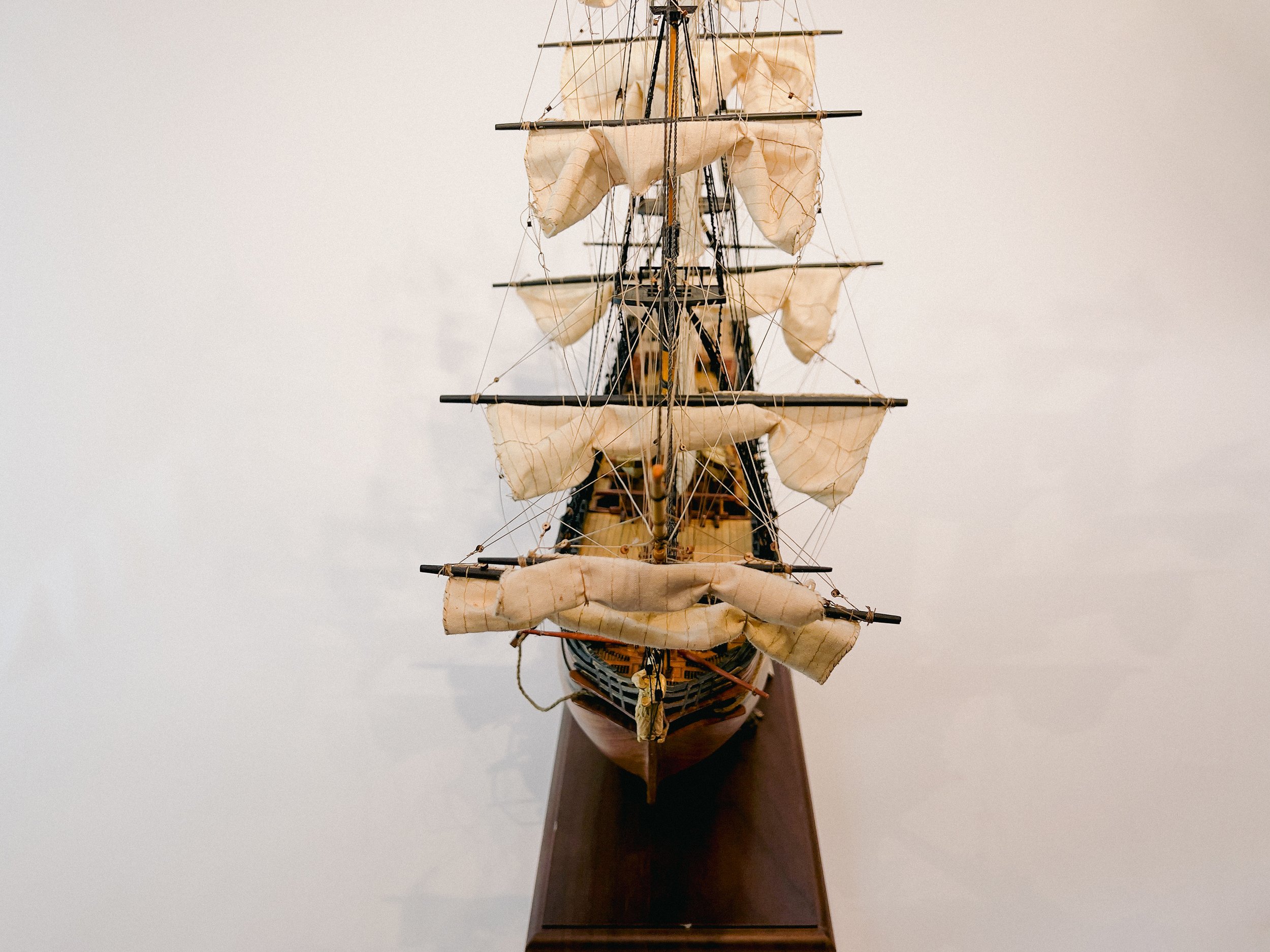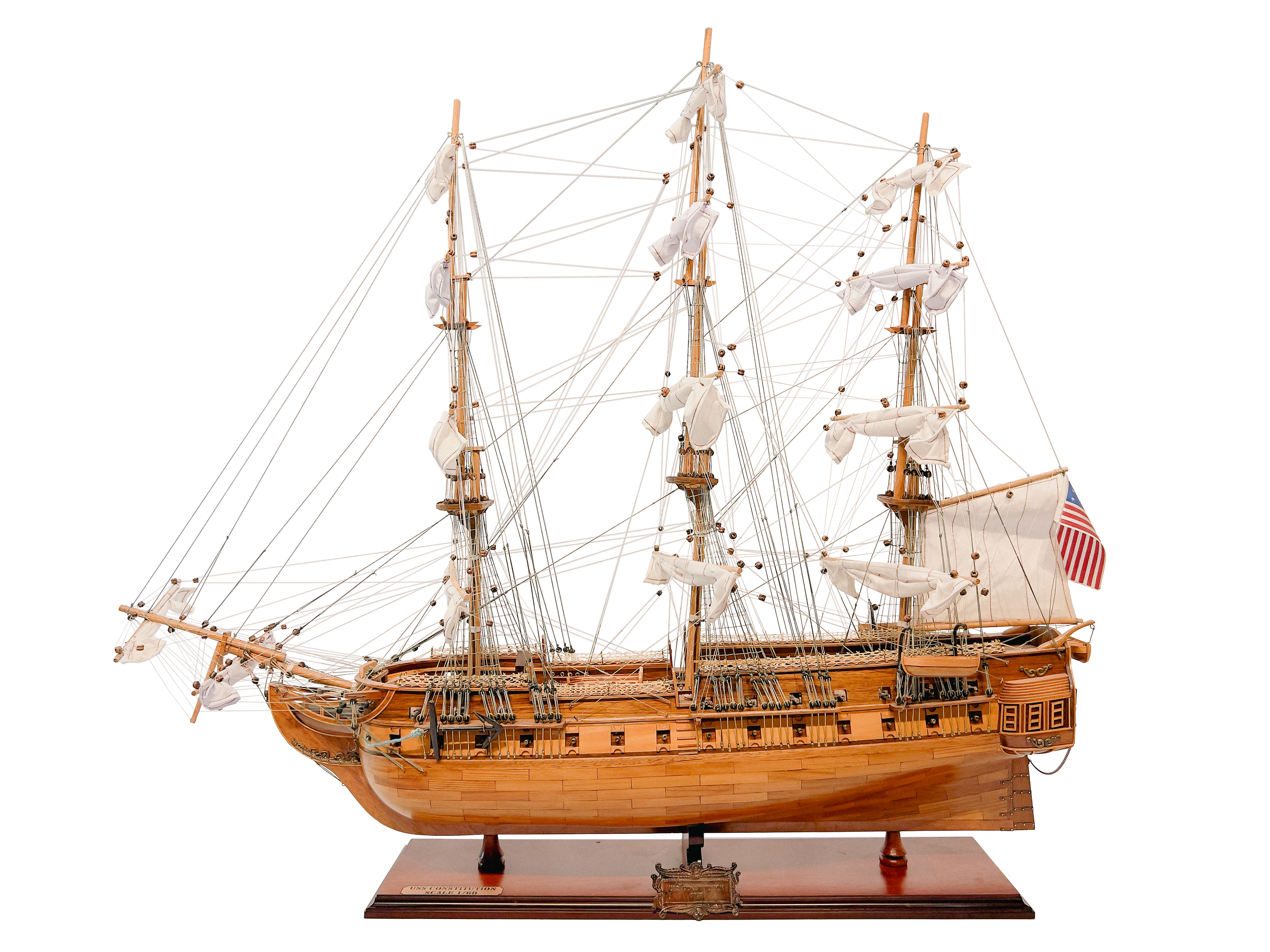zoom in on model
April 24, 1790 – June 28, 1814
HMS Leopard
Scale 1/50
Credit: Museum of Military Models, Clyde, Texas. Private Collection of Warren D. Harkins.ON VIEW
General Characteristics
Class and type:
50-gun Portland-class fourth rate
Tons burthen:
1,055 75⁄94 (bm)
Length:
146 ft 5 in (44.6 m) (overall)
120 ft 0+3⁄4 in (36.6 m) (keel)
Beam:
40 ft 8 in (12.4 m)
Depth of hold:
17 ft 6 in (5.33 m)
Propulsion: Sails
Sail plan: Full-rigged ship
Complement: 350
Armament:
Upper deck: 22 × 12-pounder guns
Lower deck: 22 × 24-pounder guns
QD: 4 × 6-pounder guns
Fc: 2 × 6-pounder guns
Description
HMS Leopard was a 50-gun Portland-class fourth rate of the Royal Navy. She served during the French Revolutionary and Napoleonic Wars and was notable for the actions of her captain in 1807, which were emblematic of the tensions that later erupted in the War of 1812 between Britain and America. She was wrecked in 1814.
The incident between HMS "Leopard" and USS "Chesapeake" that sparked the Chesapeake-Leopard Affair. Fred S. Cozzens - Drawing by Fred S. Cozzens published in 1897. Die Chesapeake-Leopard-Affaire Transferred from en.wikipedia to Commons by DaniloHergt.Ownership & Province
-
Name: Leopard
Ordered: October 16, 1775
Reordered: May 1785
Builder:
Portsmouth Dockyard (1775)
Sheerness Dockyard (1785)
Laid down:
January 1776 (Portsmouth)
May 7, 1785 (Sheerness)
Launched: April 24, 1790
Completed: May 26, 1790
Reclassified: Troopship in 1812
Honors & Awards:
Naval General Service Medal with clasp "Egypt"
Fate: Wrecked on June 28, 1814
History & Related Content
Construction and commissioning
She was first ordered on 16 October 1775, named on 13 November 1775, and laid down at Portsmouth Dockyard in January 1776. She was reordered in May 1785, ten years after having first been laid down, and construction began at Sheerness Dockyard on 7 May 1785. Work was at first overseen by Master Shipwright Martin Ware until December 1785, and after that, by John Nelson until March 1786, when William Rule took over. She was launched from Sheerness on 24 April 1790 and was completed by 26 May 1790. She was commissioned for service in June of that year under her first commander, Captain John Blankett.
Service
The China fleet of East Indiamen left Macao on 21 March 1791. Leopard and Thames escorted them as far as Java Head.
French Revolutionary Wars
On 24 October 1798, Leopard captured the French privateer vessel Apollon, which was under the command of Captain La Vaillant. On 22 August 1800 Leopard captured Clarice.
Because Leopard served in the navy's Egyptian campaign (8 March – 8 September 1801), her officers and crew qualified for the clasp "Egypt" to the Naval General Service Medal that the Admiralty issued in 1847 to all surviving claimants.
Napoleonic Wars
Leopard left Britain on 30 March 1806 as an escort to a convoy that included Asia, Lady Burges, Lord Melville, Lord Nelson, and Sovereign. During the night of 20 April, Lady Burges wrecked on a reef off Boa Vista, Cape Verde. Boats from the convoy were able to rescue 150 of the 184 people on board; 34 or 38 drowned. Leopard left the convoy at Latitude 9°N and arrived at Spithead on 8 June.
The Chesapeake-Leopard Affair
In early 1807, a handful of British sailors—some of American birth—deserted their ships, which were then blockading French ships in the Chesapeake Bay, and joined the crew of USS Chesapeake. In an attempt to recover the British deserters, Captain Salusbury Pryce Humphreys, commanding Leopard, hailed Chesapeake and requested permission to search her. Commodore James Barron of Chesapeake refused and Leopard opened fire. Caught unprepared, Barron surrendered and Humphreys sent boarders to search for the deserters. The boarding party seized four deserters from the Royal Navy—three Americans and one British-born sailor—and took them to Halifax, where the British sailor, Jenkin Ratford, was hanged for desertion. The Americans were initially sentenced to 500 lashes, but had their sentence commuted; Britain also offered to return them to America.
The incident caused severe political repercussions in the United States and nearly led to the two nations going to war.
Leopard escorted a convoy from Portsmouth on 6 May 1808. Leopard left the convoy on 28 July at 35°S 7°E.
She then was part of the convoy assigned to Josias Rowley in the Mauritius campaign of 1809–11 in the Indian Ocean.
Plan and key. The Attack on Boulogne Oct 1804 The original title of this very detailed watercolour drawing, centre bottom, reads: 'A S. E. View of the Town and Harbour of Boulogne with the Encampments on the Heights. Shewing also the situation of the French and English Squadrons as taken at anchor by E. D. Lewis H.M.S. Tartarus off Boulogne'. The flagship, centre bottom is identified as the 'Monarch', 74, Admiral Lord Keith, then in charge of the anti-invasion blockade. Medium includes pen and black ink. [PvdM 4.05] Plan and key. The Attack on Boulogne Oct 1804 Key: 1. HMS Trusty, 2. HMS Leda, 3. HMS Autumn, 4. HMS Euryalus, 5. HMS Monarch, 6. Speculator (lugger), 7. HMS Leopard (Admiral Louis), 8. HMS Jamaica, 9. ? with the Guard, 10. ? (bomb), 11. ?Railleur (1804) (sloop), 12. HMS Tartarus (?bomb) repeating Monarch's signal, 13. HMS Harpy (sloop), 14. HMS Hecla (bomb), 15. HMS Vesuvius (ship, 1776), 16. HMS Devastation, 17, ?Manly 1804 (gun brig), 18. ?Jackal 1801 (gun brig), 19. ?Locust 1801 (gun brig), 20. ?Monkey 1801 (gun brig), 21. ?Discovery 1789 (?bomb), 22. ?Mariner 1801, 24. HMS Active, 26. Fly By Night (Lugger), 27. ? Battery, 28. ? Point, 29. Batteries, 30. Pier head, 31, ? station in the harbour, 32, The Telegraph, 33. The Encampment, 34. The Telegraph on Telegraph Hill, 35. An Admiral flag in the harbour, 36. The flotilla, 37. The ? flying the Admirals flag, 38. A battery carrying ? line of guns on the pier head, 39. The light house. E.D. Lewis.Fate
In 1812, Leopard had her guns removed and was converted to a troopship. On 28 June 1814, she was en route from Britain to Quebec, carrying a contingent of 475 Royal Scots Guardsmen, when she grounded on Anticosti Island in heavy fog. Leopard was destroyed, but all on board survived.
Barron surrenders to Humphreys aboard Chesapeake.Leopard in fiction
In Patrick O'Brian's novel Desolation Island, the fifth book of the Aubrey–Maturin series, Jack Aubrey commands Leopard on a cruise through the Atlantic and Indian oceans after the Chesapeake-Leopard Affair, a voyage which included the sinking of the fictional Dutch ship of the line Waakzaamheid, and a disastrous collision with an iceberg. In the sixth book, The Fortune of War, the ship is left at a British station in the Dutch East Indies, unable to support her complement of guns. She is called the "horrible old Leopard" in the fourth book in the series The Mauritius Command, and in other books in the series, and ends its days as a store ship sailing from the English Channel to the Baltic.
Game developer Lucas Pope based the layout of the titular ship in his game Return of the Obra Dinn on the layout of the HMS Leopard.


































